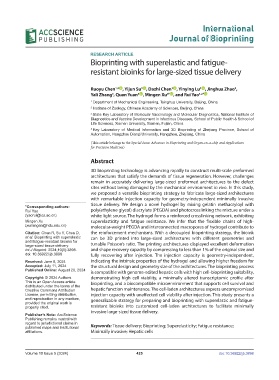Page 433 - IJB-10-5
P. 433
International
Journal of Bioprinting
RESEARCH ARTICLE
Bioprinting with superelastic and fatigue-
resistant bioinks for large-sized tissue delivery
Ruoyu Chen 1,2 id , Yijun Su 1 id , Dazhi Chen 1 id , Yinying Lu 1 id , Jinghua Zhao ,
3
Yali Zhang , Quan Yuan 3 id , Mingen Xu 4* id , and Rui Yao 1,2* id
3
1 Department of Mechanical Engineering, Tsinghua University, Beijing, China
2 Institute of Zoology, Chinese Academy of Sciences, Beijing, China
3 State Key Laboratory of Molecular Vaccinology and Molecular Diagnostics, National Institute of
Diagnostics and Vaccine Development in Infectious Diseases, School of Public Health & School of
Life Sciences, Xiamen University, Xiamen, Fujian, China
4 Key Laboratory of Medical Information and 3D Bioprinting of Zhejiang Province, School of
Automation, Hangzhou Dianzi University, Hangzhou, Zhejiang, China
(This article belongs to the Special Issue: Advances in Bioprinting and Organ-on-a-chip and Applications
for Precision Medicine)
Abstract
3D bioprinting technology is advancing rapidly to construct multi-scale preformed
architectures that satisfy the demands of tissue regeneration. However, challenges
remain in accurately delivering large-sized preformed architectures to the defect
sites without being damaged by the mechanical environment in vivo. In this study,
we proposed a versatile bioprinting strategy to fabricate large-sized architectures
with remarkable injection capacity for geometry-independent minimally invasive
tissue delivery. We design a novel hydrogel by mixing gelatin methacryloyl with
*Corresponding authors:
Rui Yao poly(ethylene glycol) diacrylate (PEGDA) and photocrosslinking the mixture under a
(yaorui@ioz.ac.cn) white light source. The hydrogel forms a reinforced crosslinking network, exhibiting
Mingen Xu superelasticity and fatigue resistance. We infer that the flexible chains of high-
(xumingen@hdu.edu.cn) molecular-weight PEGDA and interconnected macropores of hydrogel contribute to
Citation: Chen R, Su Y, Chen D, the reinforcement mechanisms. With a decoupled bioprinting strategy, the bioink
et al. Bioprinting with superelastic can be 3D printed into large-sized architectures with different geometries and
and fatigue-resistant bioinks for
large-sized tissue delivery. tunable Poisson’s ratio. The printing architectures displayed excellent deformation
Int J Bioprint. 2024;10(5):3898. and shape recovery capacity by compressing to less than 1% of the original size and
doi: 10.36922/ijb.3898 fully recovering after injection. The injection capacity is geometry-independent,
Received: June 8, 2024 indicating the intrinsic properties of the hydrogel and allowing higher freedom for
Accepted: July 11, 2024 the structural design and geometry size of the architectures. The bioprinting process
Published Online: August 20, 2024 is compatible with genome-edited hepatic cells with high cell-bioprinting suitability,
Copyright: © 2024 Authors. demonstrating high cell viability, a minimally altered transcriptomic profile after
This is an Open Access article bioprinting, and a biocompatible microenvironment that supports cell survival and
distributed under the terms of the
Creative Commons Attribution hepatic function maintenance. The cell-laden architectures express uncompromised
License, permitting distribution, injection capacity with unaffected cell viability after injection. This study presents a
and reproduction in any medium, generalizable strategy for preparing and bioprinting with superelastic and fatigue-
provided the original work is
properly cited. resistant bioinks into customized cell-laden architectures to facilitate minimally
invasive large-sized tissue delivery.
Publisher’s Note: AccScience
Publishing remains neutral with
regard to jurisdictional claims in
published maps and institutional Keywords: Tissue delivery; Bioprinting; Superelasticity; Fatigue resistance;
affiliations. Minimally invasive; Hepatic cells
Volume 10 Issue 5 (2024) 425 doi: 10.36922/ijb.3898

